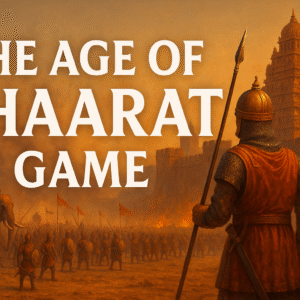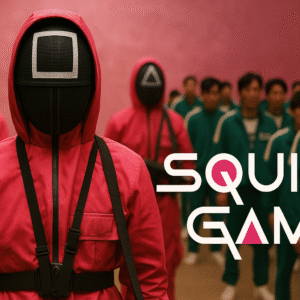Table of Contents
A New Chapter in Indian Gaming
In 2025, India witnessed something different. Amid global hits like Call of Duty, Genshin Impact, and PUBG, an unexpected player entered the arena — The Age of Bhaarat game. Designed with the soul of Indian history, strategy, and regional pride, this game didn’t just aim to entertain. It aimed to educate, stir emotion, and bring the glorious past of Bharat (India) to the screens of millions.
When I first heard of The Age of Bhaarat game, I assumed it was just another mythological cash-grab with a flashy name. But once I played it, something shifted. I wasn’t just commanding avatars. I was navigating the ancient trade routes, forming alliances among dynasties, and witnessing war elephants storm enemy gates.
This blog explores the deeper story behind the game — how it was created, why it’s gaining momentum, what makes it unique, and how it reflects the mindset of a new generation of Indian gamers.
The Origin Story: Born in the Heart of Bharat
The Age of Bhaarat game wasn’t developed by a giant multinational studio. It was crafted by a mid-size Indian team, “Sanskriti Interactive,” based in Pune. Founded by three IIT graduates and one game designer from NID, their goal was simple: create a strategy game rooted entirely in Indian history, not Western fantasies.
Their journey began with research. Over 18 months, the team consulted with historians from Jawaharlal Nehru University, read original Sanskrit texts, and built timelines starting from the Indus Valley Civilization to the Maratha Empire. This wasn’t just about gameplay mechanics — it was about respecting India’s complex heritage.
As one of the developers shared in an interview:
“We didn’t want India to be a skin on top of a Western engine. We wanted The Age of Bhaarat game to feel like India — in music, visuals, and strategy.”
And they did it. The game features original soundtracks based on Carnatic and Hindustani traditions, languages that adapt based on chosen regions (yes, even Assamese and Bodo), and resource mechanics tailored to Indian geography like monsoon cycles, cotton trade, and spice routes.
Gameplay Mechanics: Depth Over Decoration
Unlike many mobile strategy games where you build and forget, The Age of Bhaarat game demands real strategy. You start as a local ruler — maybe from Magadha, Chola, Ahom, or even the Cheras — and must grow your empire via alliances, trade, agriculture, and yes, war. But here’s the twist: violence isn’t always the path to victory.
For instance, players can win by becoming a spiritual center, developing Sanskrit universities, or controlling pilgrimage routes. The inclusion of non-violent victory paths sets it apart from games like Age of Empires or Clash of Clans. It’s refreshing to see a game that allows cultural influence to matter as much as brute force.
Also, a standout feature is regional voiceovers and storytelling. Playing as a ruler in the Northeast? You’ll hear traditional Bodo folk tunes and dialects. Going South? Expect temple architecture, local spices as trade resources, and Tamil manuscripts shaping education policies.
Gamers in forums like Reddit India Gaming and Discord communities are already comparing strategies and praising its originality.
Real Historical Integration: More Than Just Names
The Age of Bhaarat game doesn’t just throw in Ashoka or Akbar for name value. Each leader, policy, and technological upgrade is grounded in history. For example:
- Ashoka’s Edicts give you diplomatic boosts.
- Chanakya’s Arthashastra increases your espionage and taxation efficiency.
- Rani Durgavati’s leadership buffs guerrilla tactics in forested terrain.
The realism is backed up with citations and unlockable historical quotes, something I personally found inspiring. After completing a campaign with the Vijayanagara Empire, I went on a Wikipedia binge about Krishnadevaraya’s rule. That’s the impact good games can have.
According to Gaming Central India, over 1.2 million downloads happened in the first month. Around 40% of the players are under 25 — proof that The Age of Bhaarat game is reaching India’s most active gaming demographic.
Case Study: How a College Tournament Boosted Popularity
A turning point in the game’s popularity came from an unexpected place: college eSports. In February 2025, IIT Madras held an inter-college tournament featuring The Age of Bhaarat game. It was streamed on YouTube and garnered 2.3 million views in under a week.
What made it go viral? For starters, the final match wasn’t won with war but through an intellectual victory route, where the player built a chain of Nalanda-like universities, attracted scholars, and formed cross-regional alliances.
Clips of this gameplay flooded platforms like Instagram Reels and YouTube Shorts. Suddenly, the game wasn’t just for strategy nerds — it became a talking point among everyday users.
The tournament also included commentary by Indian historians, explaining the background of each in-game event. It blurred the line between gaming and education — and that’s exactly what the creators wanted.
Mobile Optimization and Monetization Model
One of the biggest achievements of The Age of Bhaarat game is its optimization for low-end Android phones. While it runs better on PCs, the game was clearly designed for Indian users — light on memory, offline campaign mode, and no forced ads.
Its monetization strategy is another smart move. Instead of loot boxes or “pay-to-win” features, it offers a flat one-time fee to unlock all features, with optional DLCs for special campaigns like the Delhi Sultanate or the Vedic Age.
I paid ₹399 for the full version. Honestly? It was worth every rupee. No annoying energy bars. No pop-up ads. Just gameplay. This model builds long-term trust, unlike many games that bait users with free access and then block progress unless you spend money.
In fact, as per App Annie, The Age of Bhaarat game entered the top 10 paid strategy games in India within just 3 weeks of launch.
Community Response: A Cultural Wake-Up Call
Within weeks of release, The Age of Bhaarat game found itself at the center of conversations — not just among gamers, but educators, history buffs, and even political commentators. What stood out was the emotional connection users reported.
On social media platforms like X (formerly Twitter) and Koo App, users began sharing moments from the game that resonated with their roots. A user from Kerala posted,
“I never thought I’d see the Chera dynasty in a video game. Felt like my grandparents’ stories came to life.”
Even government educational platforms like Diksha and some private schools started experimenting with using the game during history lessons, especially for middle and senior school students. Some teachers encouraged students to complete a Chola dynasty campaign and write a report on it. It blurred the line between gaming and active learning — in a very real way.
The Reddit thread titled “Why The Age of Bhaarat game hits differently” received over 3,000 upvotes in 48 hours, filled with comments comparing the emotional weight of Bhaarat to generic Western games.
While many Indian games tend to rely heavily on mythology or Bollywood tie-ins, The Age of Bhaarat game dared to go into the depths of history — and people noticed.
Developer Insights: Passion Over Profit
In a behind-the-scenes YouTube video published on the channel Sanskriti Interactive Studios, the development team broke down their core design philosophy. They admitted that commercial success wasn’t the top priority. They wanted to make a game they would’ve loved growing up.
One of the co-founders, Saurabh Patil, shared:
“We weren’t just building a game. We were correcting a gap. Growing up, we played games that taught us about British knights or Greek gods. Where were the Mauryas? The Ahoms? The Satavahanas? That’s what The Age of Bhaarat game brings.”
The team collaborated with regional artists to design architecture styles accurately — from temple gopurams in the south to bamboo settlements in the northeast. They also worked with voice actors to maintain linguistic authenticity, avoiding overused Sanskritized Hindi in favor of true regional dialogues.
Interestingly, the team chose not to include “magical powers” or “gods descending from the sky,” a trope common in Indian mobile games. This grounded realism gave The Age of Bhaarat game a level of dignity and seriousness rare in the Indian game development ecosystem.
Comparisons with Other Indian Titles
Let’s address the elephant in the room: Is The Age of Bhaarat game better than its competitors?
To answer that, we need context. In recent years, Indian games like Raji: An Ancient Epic and FAU-G tried to ride the wave of national pride. While Raji earned acclaim for its visuals and story, it remained a linear single-player experience. FAU-G, on the other hand, faced backlash for weak gameplay and shallow content.
Compared to them, The Age of Bhaarat game shines because:
- It blends strategic depth with cultural education
- Offers replayability across dozens of dynasties
- Supports both mobile and PC platforms
- Provides an offline mode, a boon for tier-2 and tier-3 users in India
Moreover, while most Indian games focus on action or mythology, this one opens the door to real-time empire building. It’s more comparable to Civilization VI or Europa Universalis than anything from the Indian gaming space.
In fact, some YouTubers like Anurag Plays and GamerAjayYT have already uploaded gameplay series comparing The Age of Bhaarat game with international strategy hits.
Long-Term Impact: Not Just a Game, But a Movement
When a game becomes a conversation starter in cultural festivals, school classrooms, and even local TV news, you know it’s something more than a game.
Many believe The Age of Bhaarat game could pave the way for a new genre of culturally embedded games. Instead of trying to Westernize Indian narratives, it inspires devs to make content for Indians, by Indians.
According to a report by NASSCOM, India’s gaming industry is expected to cross $8.6 billion by 2027. With a growing number of youth craving content that reflects their identity, the demand for games like The Age of Bhaarat game will only rise.
There are also whispers that the creators are planning a multiplayer expansion where players from different regions can form live alliances and trade — possibly laying the groundwork for the first real-time pan-Indian strategy MMO.
And personally? As someone who has played strategy games for over a decade, this feels like a turning point. It’s no longer about mimicking the West. It’s about owning our stories, maps, heroes, and conflicts. And The Age of Bhaarat game proves that it can be done — and done well.
Personal Commentary: Why This Game Mattered to Me
Let me take a step back from the analysis and talk about something personal.
I’ve played games like Age of Empires II, Crusader Kings III, and even Rise of Nations. They’re great. But they never connected me to who I am. I could conquer Europe but didn’t feel like I was learning my own story.
When I played The Age of Bhaarat game as a small ruler from the Kamarupa kingdom (present-day Assam), I felt seen. I built rice farms on river banks, managed monsoon trade disruptions, and even developed Sanskrit schools. That felt different. That felt real.
And that’s the power of well-made games. They don’t just entertain — they inform, inspire, and sometimes even heal.
My cousin, who used to struggle with history in school, now knows more about the Chalukyas than I ever did at his age — just from playing the game. His words:
“It doesn’t feel like studying. It feels like living history.”
That’s when I knew this game had achieved something rare.
What’s Next: Updates, DLCs, and Global Expansion
The team behind The Age of Bhaarat game isn’t stopping with the base game. According to a recent LinkedIn post, Sanskriti Interactive has ambitious plans for rolling out six major DLCs over the next two years. These downloadable content packs will focus on lesser-known Indian historical periods and figures, including:
- The Northeast Chronicles DLC, featuring kingdoms like Dimasa and Tripura
- Deccan Fortresses, focusing on the rise and fall of Golconda and Bijapur
- The Buddhist Trail, introducing a peaceful victory path through monastic diplomacy
- Colonial Resistance Mode, offering players a way to navigate India’s fragmented resistance against colonialism before 1857
There are also plans to launch multiplayer alliances where users from different states can collaborate to form a pan-Bharat alliance against invaders — a subtle but powerful metaphor for modern India’s unity in diversity.
From a business standpoint, the team is in talks with partners to translate the game into 15+ languages, including French, German, Japanese, and Korean. This is part of a broader goal to introduce The Age of Bhaarat game to the global market, especially in strategy-heavy gaming communities like Japan, South Korea, and Eastern Europe.
The developers hinted at a Steam release and console port, though no timeline has been confirmed. If they succeed, this might be the first Indian strategy title to make it to global eSports and international forums like Twitch and Steam.
Real Cultural Change: More Than a Trend
It would be easy to say The Age of Bhaarat game is just a “flavor of the month.” But its impact feels deeper. It has led to:
- Educators adding game-based learning to history classes
- Regional content creators making lore videos about Indian kingdoms
- Young developers feeling empowered to create culturally authentic games
In fact, within months of its release, two more indie studios have announced India-centric games — one on the Silk Road through Ladakh and another on ancient port cities like Lothal and Poompuhar.
This shift is crucial because, for too long, Indian history in gaming was either absent or stereotyped. Either we were “mystical sages” or “snake charmers.” The Age of Bhaarat game changes that narrative with research-backed gameplay, not token representation.
When The Age of Bhaarat game hits 10 million users (and it will soon), it won’t just be a victory for Sanskriti Interactive. It’ll be a signal to the entire Indian game development ecosystem — that building for India, with India’s voice and vision, can be both profitable and globally admired.
Final Thoughts from the Author
As someone who has worked in the digital world and played games since the Age of Empires II CD days, I never imagined I’d play a game where I’d manage the kingdom of Kalinga while protecting river trade from early Portuguese threats — all while listening to a Carnatic flute loop in the background.
The Age of Bhaarat game isn’t perfect. It still has minor UI glitches, occasional lag on older phones, and a slightly steep learning curve for casual players. But these feel like small issues in a game that does something big — it makes Indian history feel alive and playable.
In many ways, this game is doing what schoolbooks often fail to do: making people care about their heritage. And if a strategy game can do that while also being fun and challenging, then that’s more than a win. That’s a legacy.
Frequently Asked Questions (FAQs)
1. What is The Age of Bhaarat game about?
The Age of Bhaarat game is a real-time strategy game focused on Indian history, where players build empires, form alliances, and expand influence through cultural, spiritual, economic, or military means.
2. Is The Age of Bhaarat game historically accurate?
Yes, the game incorporates real dynasties, leaders, policies, architecture, and trade systems based on historical research and expert consultation.
3. Can I play The Age of Bhaarat game on a low-end phone?
Absolutely. The developers optimized the game for Indian mobile users, making it lightweight with an offline mode.
4. Is it free to play?
The base game is free, but advanced campaigns and features can be unlocked with a one-time ₹399 fee — no forced ads, no loot boxes.
5. Are there multiplayer modes?
Not yet, but developers have announced that multiplayer co-op and alliance-based gameplay are in development for upcoming updates.
6. Where can I download it?
You can download The Age of Bhaarat game from the Google Play Store, Apple App Store, or play the beta version on Steam.
7. Is it available in regional languages?
Currently, it supports Hindi, English, Tamil, Bengali, and Marathi. More languages are planned for the next release cycle.
8. Who developed The Age of Bhaarat game?
It was created by Sanskriti Interactive, an Indian game development studio founded by IIT and NID graduates.
9. Does the game include Indian mythology?
No, the focus is on historical realism — real leaders, battles, trade, and cultural shifts, without supernatural elements.
10. How is it different from other strategy games?
It prioritizes Indian cultural depth, offers unique victory paths (spiritual, educational), and reflects India’s diverse geography and political history with remarkable detail.
More Than Just a Game
In 2025, the world doesn’t need just another game. It needs stories that matter — stories that tell us who we are and where we come from. The Age of Bhaarat game does that in the most surprising way: through resource management, battle tactics, alliances, and university-building.
It doesn’t preach. It lets you experience. And in doing so, it invites you to understand the legacy of your ancestors — not just read about them.
In this digital yug, The Age of Bhaarat game isn’t just a win for Indian gaming. It’s a declaration that our stories are worth telling, and we have the tools to tell them ourselves.
So if you haven’t tried it yet, maybe it’s time you did.



Leave a Reply